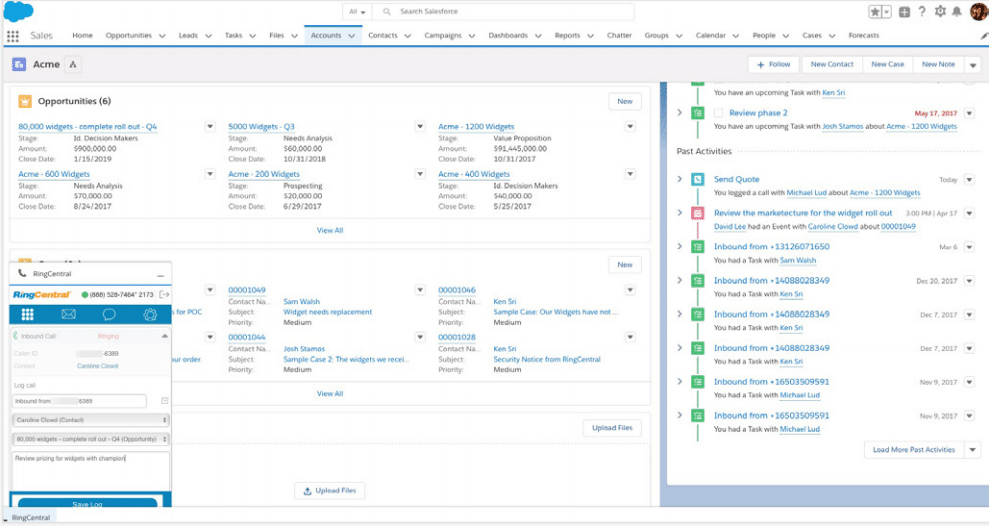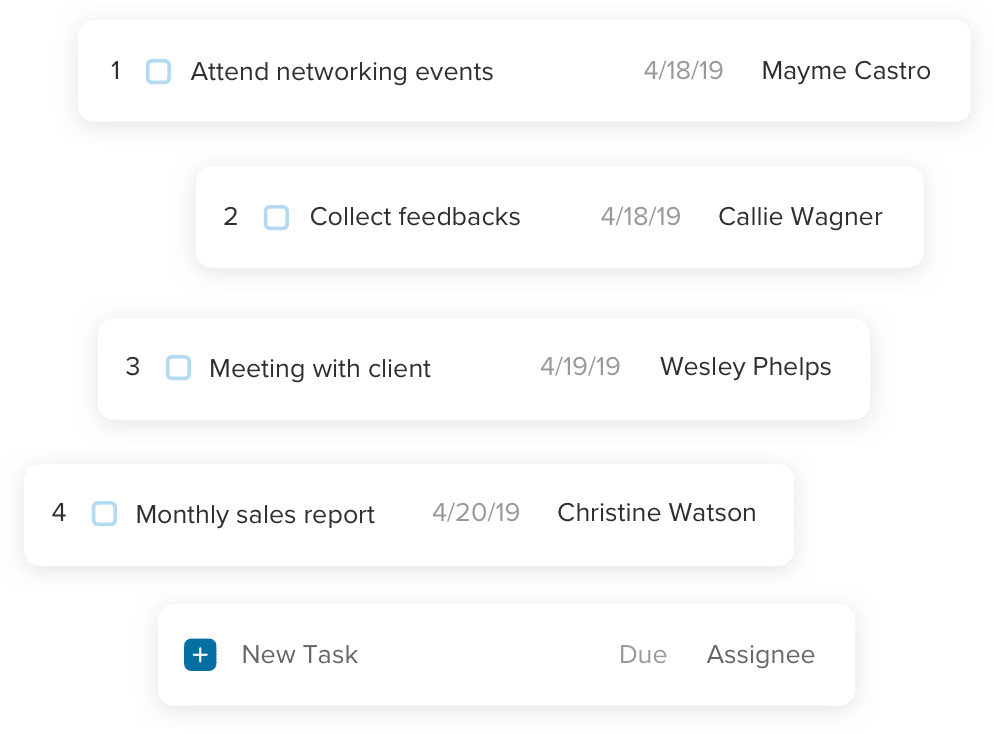When a sales meeting goes smoothly, you can feel like you’re on top of the world. You’ve closed a new deal, you’ve accomplished your goal––and it feels great. You’re riding high for the rest of the day.
But when a sales meeting doesn’t go as you planned, it’s not just a let down––it can be anxiety-inducing. You end up with a pit in your stomach wondering what went wrong for days (or even weeks).
One simple way to control the direction of your client sales meeting is by creating an agenda. A client sales meeting agenda can help you stay focused and ensure you hit all your main points. When the call is finished, you’ll know you didn’t miss anything important that could have cost you the deal.
Keep reading to learn how you can create an agenda for your next client sales meeting.
👀 Grab your set of 5 free meeting agenda templates—each one tailored for a different type of meeting.
5 things to add to your client sales meeting agenda
Creating a sales meeting agenda is relatively easy. Here are five steps to follow to help your next client sales meeting stay on track.
1. A goal for your meeting
The goal of a sales meeting with a client may feel obvious––you want to sell. But is that a realistic goal for this specific conversation? If you’re still in the early phases of the deal, you probably need to break that ultimate “sell” goal into smaller parts.
Take a look at your sales funnel and identify where you currently are with this specific prospect. What do they need to move to the next phase? The answer might be more education on what you have to offer, proof that you can provide a solution to suit their unique needs, or assistance in making a final decision and making a purchase.
The goal of your meeting should be to move the prospect to the next phase of the sales process, whatever that may be. Setting these smaller intentions (rather than just going straight to the finish line) can make sure you’re truly helping your prospect, not just trying to get their money.
Make your goal clear at the beginning of the meeting. For example, tell your client, “By the end of this meeting, I’d like to better understand your challenges so I can make a more educated recommendation.”
Why is it helpful?
Goals help you stay focused. Without an intention for your meeting, both you and your client are left wondering what you accomplished––if anything at all. Setting goals early in the meeting makes sure you’re moving the client through the sales funnel the right way.
Start closing more deals. Grab the free outbound sales playbook.
2. A loose timeline
It’s easy to get carried away chatting on a call. If you don’t have a plan, you can run out of time before you ever get to the meat of your conversation.
While you don’t want a timeline so strict the call has no natural flow, it’s helpful to have a loose guide to follow to make sure you’re able to touch on your main points—and it can prevent you from wasting time too.
Break down your goal into smaller tasks you need to accomplish while on the call. What information do you need to cover or what questions do you need to ask the client to make the call “successful”?
Create a list of bullet points of topics you’d like to go over during the meeting. Then, designate a specific amount of time for each topic. Make sure the time you’re allotting is proportional to the severity or importance of the topic, so don’t worry if all your points aren’t weighted equally.
Make sure you’re working within the restraints of your scheduled meeting. If you only have half an hour planned, make sure your timeline fits within those constraints. Don’t take more of your client’s time than they’ve given.
Why is it useful?
A loose timeline helps you stay on track, especially when you have a lot of topics to cover. It provides structure without making your meeting too rigid.
3. Time to build the relationship
Client sales meetings can feel like business, business, business. But when it comes to closing a deal, clients will want to buy from someone they trust––and someone they feel truly cares about their best interests.
If your sales meeting begins with a hard sales pitch, it can be an immediate turn-off for your client. Coming on too strongly could push them away, potentially forever.
No matter how new or old your relationship with this client is, schedule time to build rapport. Work time into the beginning of the schedule to ask about their unique needs, their day, and if they feel comfortable sharing, aspects of their personal life, like if they have kids or where they’re from.
As you get to know your client better, use this opportunity to keep that conversation going. Remember the small details about them, like their favorite football team or where their children attend college, so you can show them they’re more than just a number.
Work some rapport-building time into your schedule, possibly at the beginning of the call. Using those first few minutes to chat can set the tone for the rest of the conversation.
Why is it helpful?
Rapport can help create a memorable encounter for your clients. When you connect on something beyond business or the deal, customers will feel comfortable with you and want to continue the conversation.
Log information in your sales software or CRM so you have quick refresher notes for your next meeting. Stop scribbling important client details on sticky notes or saving them in different sales apps. Keep all your information stored in your CRM for safekeeping and easy accessibility.
For example, you could integrate your CRM with your phone system, like RingCentral. Customer information is right at your fingertips before, during, and after each meeting. A screen pop-up instantly appears for each call, providing the caller’s details and records so you don’t need to scramble to remember where you put your notes:
4. Opportunities for questions
When setting your agenda for your next client meeting, you may feel tempted to fill all the time. After all, you don’t want to feel underprepared or leave space for awkward silence.
But when you fill your meeting’s entire schedule with talking, presentations, and one-sided questions, it doesn’t give your client an opportunity to engage. They might have questions, concerns, or ideas of their own they’d like to share.
When setting your client meeting agenda, be sure to leave time for questions and conversations. You can do this entirely at the end of the meeting or as you go, maintaining the flow of the meeting.
Why is it helpful?
Setting time aside for your client to contribute ensures both parties get a chance to speak, making the meeting more productive and giving you an opportunity to shift your pitch depending on the questions your client asks.
Set clear communication channels for questions and concerns after the meeting.
How many times have you left a meeting wishing you’d made a specific point or asked a certain question, but you weren’t sure how to follow up? Avoid this happening to your clients by making it clear where and how they can get in touch after the meeting, for example, by calling or texting you. If you have a communication platform like RingCentral, you can take business calls and texts from your personal phone—without giving away your personal number.
5. Next steps
Before you end your meeting, establish the next steps you or the client should take to move the deal to the next phase.
Did you promise to follow up with additional reading on a product or service you discussed? Are you going to pull a quote to share? Does the client need to get back to you on the number of items they’d like to purchase?
Spend the last few minutes reiterating your expectations and let the client know what they can expect from you. Make sure you both leave on the same page and layout a timeline for when those next steps can happen.
Why is it helpful?
Everyone walks away from the meeting knowing what to expect. No more waiting to hear from the client while they’re also waiting to hear from you.
Keep track of action items as you go.
Make sure you never miss an important step by keeping track of action items as the meeting goes on. A communication tool, like the RingCentral app, allows you to easily share the next steps with your sales team and assign tasks and due dates to make sure things get done.
Take it one step further by inviting your prospects to the RingCentral app, making it easy for them to follow up on action items of their own and keep the conversation going through video, phone, or messaging after your meeting has ended:
Build a client sales meeting agenda that results in awesome meetings
The agenda for your client sales meeting will likely look a little different every time.
Be flexible, but prepared—and think through these five points each time you create a sales meeting agenda to create a structure that makes sure you don’t miss anything important.

Originally published Mar 16, 2020, updated Jul 30, 2021







